Arthroscopic Elbow Reconstruction Surgery in Chennai is a modern, minimally invasive procedure designed to diagnose and treat complex elbow joint issues. It is especially effective for patients with ligament injuries, joint instability, stiffness, and damaged cartilage.This advanced technique uses small incisions and specialized instruments to reconstruct the elbow joint while preserving surrounding tissues. Patients benefit from reduced pain, quicker recovery, and improved joint function.
What is Arthroscopic Elbow Reconstruction?
Arthroscopic elbow reconstruction is a surgical technique that allows orthopedic surgeons to repair and reconstruct damaged parts of the elbow using an arthroscope—a small camera inserted through tiny incisions. This procedure is especially valuable for treating elbow instability, severe ligament injuries, and joint degeneration.
Unlike traditional open surgery, Arthroscopic Elbow Reconstruction Surgery in Chennai provides better visualization of the joint with minimal tissue disruption.

Conditions Treated
This advanced procedure is used for a range of elbow conditions, particularly when conservative treatments have failed.
1. Ligament Tears and Instability
When the elbow’s ligaments are torn due to trauma or repetitive stress, it can lead to instability. Arthroscopic Elbow Reconstruction Surgery in Chennai helps by reconstructing the damaged ligaments, restoring strength and function.
This is especially relevant for those seeking Elbow ligament repair surgery in Chennai, offering a long-term solution with minimal scarring and discomfort.
2. Joint Degeneration and Arthritis
Degenerative conditions such as arthritis may require smoothing of the bone surfaces or removing damaged cartilage. In some advanced cases, patients may be evaluated for Elbow Replacement surgery in Kolathur, especially when joint reconstruction alone may not be sufficient.
3. Post-Traumatic Elbow Stiffness
Elbow stiffness following an injury or surgery can severely limit range of motion. Arthroscopy allows surgeons to release tight capsules and scar tissue, restoring mobility.
For patients in need of Elbow joint arthroscopy surgery in Kolathur, this procedure offers a safe and effective solution.
4. Loose Bodies and Cartilage Damage
Tiny fragments of cartilage or bone within the elbow joint can cause pain and locking. These can be removed through Arthroscopic Elbow Reconstruction Surgery in Chennai, offering relief with minimal invasion.
Minimally Invasive Techniques
The use of arthroscopy in elbow reconstruction has revolutionized the way joint damage is treated.
- Small Incisions: Reduce trauma to surrounding tissues.
- Precise Visualization: High-definition imaging of the elbow joint ensures accurate diagnosis and treatment.
- Faster Recovery: Patients undergoing Arthroscopic Elbow Reconstruction Surgery in Chennai often return to normal activities sooner than with traditional surgery.
This is also a preferred option over open procedures for those requiring Elbow ligament repair surgery in Chennai or Elbow joint arthroscopy surgery in Kolathur.
Rehabilitation and Recovery
Recovery from elbow arthroscopy involves a structured rehabilitation program to ensure the best results
Initial Post-Operative Phase
- Pain Control: Ice, anti-inflammatories, and prescribed medications help manage discomfort.
- Immobilization: A splint or brace may be used initially to protect the reconstructed area.
Movement and Strengthening
- Physical Therapy: Starts with gentle range-of-motion exercises.
- Strength Training: Gradual introduction of strengthening routines helps restore elbow function.
Patients undergoing Arthroscopic Elbow Reconstruction Surgery in Chennai should closely follow their rehabilitation plan for optimal outcomes.
Follow-up visits are especially important in areas like Kolathur, where access to specialists for Elbow Replacement surgery in Kolathur or Elbow arthroscopy surgery in Kolathur can support long-term care.
Why Choose Arthroscopic Elbow Reconstruction?
Here are some key benefits of opting for Arthroscopic Elbow Reconstruction Surgery in Chennai:
- Less Invasive: Minimal scarring and reduced tissue damage.
- Precise Results: Better outcomes due to detailed imaging.
- Quicker Return to Activities: Especially valuable for athletes and manual laborers.
- Effective for Complex Issues: From ligament repair to arthritis management.
If you’re dealing with ligament injuries, Elbow ligament repair surgery in Chennai through arthroscopy may offer long-term benefits with a faster recovery timeline.
When to Consider Surgery
You may be a candidate for Arthroscopic Elbow Reconstruction Surgery in Chennai if:
- You experience chronic elbow instability.
- Non-surgical treatments haven’t worked.
- You’re considering Elbow Replacement surgery in Kolathur but want a less invasive option.
- You need a precise and reliable solution for Elbow joint arthroscopy surgery in Kolathur.
Conclusion
Arthroscopic Elbow Reconstruction Surgery in Chennai is a state-of-the-art solution for managing severe elbow conditions with minimal invasion. By combining precision technology with surgical expertise, this procedure ensures better joint function, less postoperative discomfort, and faster recovery.Whether you’re considering Elbow ligament repair surgery in Chennai, Elbow joint arthroscopy surgery in Kolathur, or even evaluating options like Elbow Replacement surgery in Kolathur, this approach offers a balanced, effective pathway to recovery. Always consult with a qualified orthopedic specialist to determine the best treatment for your condition.
Read also: Arthroscopic Ankle Reconstruction Surgery


